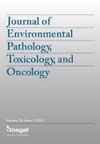基于凋亡和缺氧相关基因的胃癌预后模型的开发:对生存和免疫格局的预测性洞察力
IF 2.9
4区 医学
Q3 TOXICOLOGY
Journal of Environmental Pathology Toxicology and Oncology
Pub Date : 2024-03-01
DOI:10.1615/jenvironpatholtoxicoloncol.2024050455
引用次数: 0
摘要
背景:胃癌(GC)是全球发病率第五高的恶性肿瘤,也是造成全球癌症相关死亡的第四大因素。寻找关键的预后生物标志物和阐明胃癌进展的潜在机制需要创新的方法。在肿瘤发生过程中,细胞凋亡和缺氧错综复杂、相互依存。这项工作研究了凋亡和缺氧相关基因(AHRGs)在GC预后中的潜在价值,以及对GC患者免疫疗法的影响:对来自 TCGA 的 GC 转录组数据进行了差异表达分析。从MSigDB数据库中获取了凋亡相关基因(ARGs)和缺氧相关基因(HRGs),然后与GC中的差异表达基因(DEGs)进行交叉分析。利用单变量 Cox 回归、LASSO 分析和多变量 Cox 回归分析构建了预后模型。利用 GEO 数据集对该模型进行了验证,并对高风险组和低风险组之间的 DEGs 进行了富集分析。结合临床信息创建了一个提名图。根据多因素模型中的核心预后基因,采用非负矩阵因式分解法对肿瘤样本进行聚类。随后的分析包括免疫景观、免疫表观评分、TIDE评分以及不同亚型的化疗敏感性:结果:建立了一个基于 AHRGs 的预后模型,并在外部队列中验证了其强大的预测能力。风险评分被确定为一个独立的预后因素,与其他临床特征一起增强了预后提名图。本文章由计算机程序翻译,如有差异,请以英文原文为准。
Development of a Prognostic Model for Gastric Cancer Based on Apoptosis- and Hypoxia-Related Genes: Predictive Insights into Survival and Immune Landscape
Background: Gastric cancer (GC) stands as the fifth most prevalent malignancy worldwide and the fourth primary contributor to cancer-associated fatalities worldwide. The search for pivotal prognostic biomarkers and elucidation of underlying mechanisms driving GC progression necessitate innovative approaches. Apoptosis and hypoxia were intricately associated and interdependent in tumorigenesis. This work investigated the potential value of apoptosis- and hypoxia-related genes (AHRGs) in GC prognosis, with implications for immune therapy in GC patients.
Methods: Differential expression analysis was performed on GC transcriptomic data from TCGA. Apoptosis-related genes (ARGs) and hypoxia-related genes (HRGs) were obtained from the MSigDB database, followed by intersection analysis with differentially expressed genes (DEGs) in GC. A prognostic model was constructed using univariate Cox regression, LASSO analysis, and multivariate Cox regression analyses. The model was validated using a GEO dataset, and DEGs between high- and low-risk groups were subjected to enrichment analysis. A nomogram was created by incorporating clinical information. Non-negative matrix factorization based on core prognostic genes from the multifactorial model was employed to cluster tumor samples. The subsequent analyses encompassed immune landscape, immunophenoscore, TIDE score, as well as chemosensitivity for distinct subtypes.
Results: A prognostic model based on AHRGs was established, and its robust predictive capability was validated in external cohorts. Riskscore was determined as an independent prognostic factor, augmenting prognostic nomogram in conjunction with other clinical features.
求助全文
通过发布文献求助,成功后即可免费获取论文全文。
去求助
来源期刊
CiteScore
3.80
自引率
0.00%
发文量
20
审稿时长
>12 weeks
期刊介绍:
The Journal of Environmental Pathology, Toxicology and Oncology publishes original research and reviews of factors and conditions that affect human and animal carcinogensis. Scientists in various fields of biological research, such as toxicologists, chemists, immunologists, pharmacologists, oncologists, pneumologists, and industrial technologists, will find this journal useful in their research on the interface between the environment, humans, and animals.

 求助内容:
求助内容: 应助结果提醒方式:
应助结果提醒方式:


